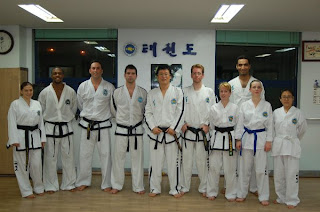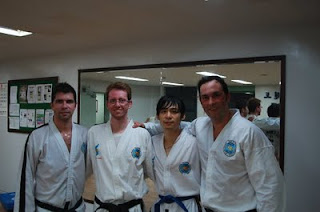
In a previous post regarding “
Defensive Techniques in Taekwon-Do” I grouped blocks in Taekwon-Do into two categories: hard blocks and soft blocks. My correspondences¹ with a fellow martial art blogger, Dan Djurdjevic of “
The Way of Least Resistance”, made me contemplate the whole issue of blocking techniques again, causing me to realise that a simple dichotomy of hard blocks versus soft blocks doesn't adequately reveal the nuances of blocking techniques in ITF Taekwon-Do.
What is a Blocking Technique?
For purposes of our discussion we need a definition for what a blocking technique is. To do this, let's start by looking at the Korean terminology. The Korean word for blocking technique is
makgi gisool 막기기술; blocking is
makgi 막기. The root verb is
makda 막다, which carry the meanings of obstruction, i.e. “to obstruct the way” 길을막다; to curb, check or prevent something from happening; to guard against something; to ward off something, like “warding off attacks” 공격을 마다 or “preventing the enemy from entering into” 적의 침입을 막다.
Based on this we can define a blocking technique as a method (typically involving a blocking tool²) to prevent an opponent's attack (i.e. his attacking tool) from entering into your sphere of safety. A blocking technique “obstructs the way” of the attack to prevent the attacking tool from reaching its target. The Korean root word reveals to us that a blocking technique is purposed to “prevent” something from happening—to ward off attacks, by somehow obstructing the way. To “prevent” the attack from reaching its target, the blocking technique has to
intercept it and to “ward off” the attack it has to
redirect its force.
Put simply, all blocks have this one thing in common: to prevent the opponent's attacking tool from reaching its target. With the exception of checking blocks, this is achieved by
intercepting and redirecting the attacker's attack.
Not all blocks achieve this goal in the same manner and some blocks have additional goals beyond merely preventing the attack from reaching its target. Part of the purpose is to also
decrease the attacker's tactical advantage and if possible, increase your own tactical advantage.
Hard Blocks / Offensive Blocks
 |
A (Front Forefist) Pressing Block in
Sitting Stance. This block literally
punches the instep of an opponent's
front kick, making it an obviously
offensive type of block.
-- Image Source. |
Apart from intercepting and redirecting, another purpose of some blocks, as I have tabled before, is also to hurt the attacking limb of the attacker. The block, therefore, acts offensively. Previously I've called these offensive-blocks “hard blocks.” See my post “
Thoughts on Hard Blocks in ITF Taekwon-Do.”
While Mr Djurdjevic (reasoning from his involvement in traditional Karate and Chinese internal styles) effectively argues against blocks also being attacks (see his post “
Why blocks are not 'strikes in disguise'”), the idea that some blocks in ITF Taekwon-Do have an offensive function is undeniable since the ITF Encyclopaedia states that the “defense itself . . . carries out the attacking role at the same time” (Volume 3, p. 185). That ITF practitioners are therefore to view some blocks as also offensive techniques is part of our tradition. However, I agree with Mr Djurdjevic that “[b]locks can be strikes – but that doesn't mean that they always are.” We ought not unnecessarily interpret every traditional block as a possible attack. In my mind there is a certain category of blocks—what I used to call “hard blocks” but now prefer to call “offensive blocks”—that has this function “to intercept and redirect” while also “[carrying] out the attacking role at the same time.”
Of course, there are also other types of blocks that are not offensive in nature.
Other Blocks
In my previous post on “
Defensive Techniques in Taekwon-Do” I proposed only two categories—hard blocks and soft blocks. Hard blocks are blocks that are also offensive and soft blocks are the rest. I've realised that this is an oversimplification. So in the rest of this post I hope to take another look at “soft blocks” and identify some other categories. So far I have identified four additional categories: deflections, diversions, disequilibriums and checks.
Deflections / Parries
All blocks intercept and redirect the attack, but it is the way in which they do so that differ. Deflections are blocks that bump into the attacking limb at an angle (sometimes acute angles, other times perpendicularly), which causes the attack to divert from its path. The amount of time the blocking tool is in contact with the attacking limb is very short—just enough to bump it off course. These blocks usually cover a relatively short distance and have a forceful “snappiness” about them.
A deflection-block can rightly be called a parry.
Examples of deflection-blocks are the waist block, some palm or back hand blocks, parries from one's sparring guard posture, on occasion some of the typical forearm blocks, some upward and downward blocks, and so on.
Diversions
 |
A Palm Hooking Block with the
Rear / Reverse Hand in
Walking Stance -- Image Source |
While a deflection-block forcefully changes the course of the attack, a diversion-block changes the attacks direction in a smoother or less forceful manner. The amount of time the blocking tool is in contact with the attacking limb is relatively longer, so that the blocking tool guides the attacking limb into a
new direction. This type of block also covers a relatively longer distance, usually in a curved path, as it guides the opponent's attack astray. Diversion-blocks are usually what we have in mind when we think of “soft blocks” and is the type of blocking one would imagine for soft style martial arts like Tai-Chi Chuan.
Examples of diversion-blocks are the
hooking block, palm pressing blocks, the circular block, and so on.
Disequilibriums
A disequilibrium is a blocking technique that aims at breaking the balance of the opponent and do so by either pushing the attacker off balance or pulling (“luring”) him off balance.
Blocks that function in a pushing manner aim to intercept the attacking tool as high up the limb as possible—the closer to the shoulder or hip the better. In fact, blocks like the pushing block target the shoulder or pelvis. If the block is done below the major joint (i.e. the elbow or knee), it is performed against the natural bend of the joint, because otherwise the lower-limb may merely bend naturally without the opponent's balance being affected. The scooping block is an example.
The luring block is “designed to put the opponent off balance or to make the attack in vain by drawing the attacking tool beyond its intended point of focus” (
ITF Encyclopaedia, Volume 3, p. 287). The luring block might function by actually pulling the attacking limb beyond its point of focus, but often it merely “leads” the limb further than intended—not necessarily holding onto the limb, but rather guiding it along the same path, beyond the opponent's position of balance. This concept is comparable to a principle found in Aikido where the opponent's vector is exploited by enhancing it.
Obstructions
There is a special name in ITF Taekwon-Do for the blocks in this category—they are known as
checking blocks. Checking blocks are authentic
blocks, in that they function as actual obstructions put in the way of the attack's path. Checking blocks do not intercept and redirect, they literally just “obstruct the way” 길을 막다. There are different types of checking blocks, but usually they involve both arms to function as barriers against the attacking limb, for instance the X-checking block or the twin-straight forearm checking block. These blocks are often used against powerful kicks, where the mass and associated force of the kicking leg will overcome the attempted interception and redirection of a much lighter and weaker forearm block.
Summary
It is possible to group blocks into a dichotomy of hard blocks and soft blocks. Although sometimes useful, this proves to be a too simplistic view of the ways blocking techniques are used in ITF Taekwon-Do. Instead, a more nuanced differentiation group blocks into five categories: (1) offensive-blocks, (2) deflections or parries, (3) diversions, (4) disequilibriums or unbalancing-blocks, and (5) obstructions or checking blocks. Offensive-blocks aim to injure the opponent's attacking limb. Parries deflect the attacking limb off course by bumping into them at an angle, which changes the trajectory. Diversion-blocks guide the attacking limb off course, often at a curve. Disequilibriums focus on breaking the balance of the opponent. Finally, checking blocks put a barrier in the path of the attack and so literally block or obstruct the way of the attack.
Read More:
The catalyst that inspired me to write this post was Mr Djurdjevic's post on “
Hard Blocks.”
Footnotes:
1. Our “correspondences” refer to comments we left each other on some posts here on my blog (see
here) and also at his blog (see
here).
2. Volume 2 of the ITF Encyclopaedia identifies the most common blocking and attacking tools; i.e. parts of the anatomy that are most commonly used for defence and offence.





















